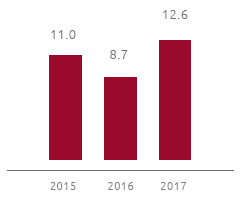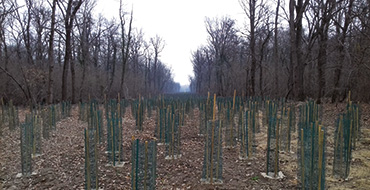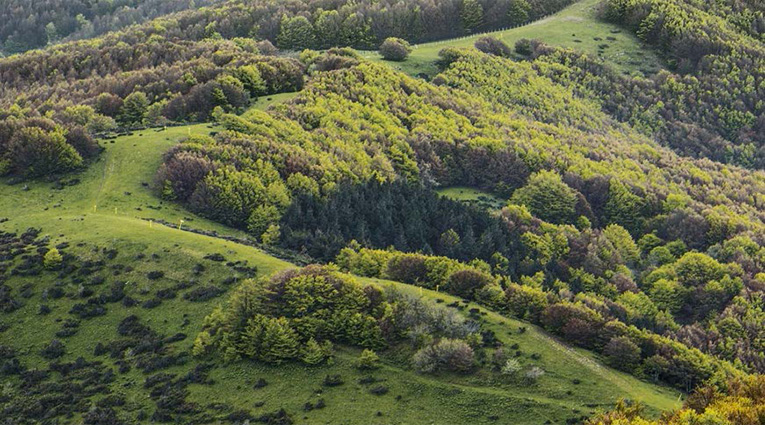Protecting biodiversity
Snam considers safeguarding nature in the areas where it operates to be of particular importance. For this reason, while construction works are in progress, it implements the most suitable design choices to minimise the biodiversity impacts generated. Once completed, it conducts environmental remediation works and monitoring projects, carried out in agreement and in cooperation with the entities in charge.
The objective of the vegetation restoration, in particular reforestation, is not merely to reconstitute forest areas but to reconstitute the landscape in general and to revive the biological functionality of vegetated areas, understood especially in their role of habitats for the fauna with specific biodiversity characteristics. Restoration and reforestation are followed by the execution of “plant care”, i.e., caring for and maintaining the bedded-out plants for a period of at least five years.
Monitoring projects concern the extensions of some methane pipelines that interfere, even marginally, with the natural local areas high in fauna and ecological value, and they are geared towards the verification of the process of re-naturalising areas affected by works, based on a comparison of conditions after the restoration (“post-completion”) and the original conditions (“pre-completion”).
Monitoring is normally performed for the most significant habitats identified in the design phase.
Natura 2000 is the main instrument in the European Union’s policy for preserving biodiversity. It was established pursuant to the Directive 92/43/EEC “Habitat” to preserve natural habitats at a Community level.
The Natura 2000 network is made up of Sites of Community Importance (SCI), which are then designated as Special Areas of Conservation (SAC), and also includes the Special Protection Areas (SPA).
The areas are not rigidly protected reserves where human activities are not allowed, in 2017, approximately 12.6 km of gas pipelines affected these areas.
During 2017, work continued for the construction of the Cervignano – Mortara pipeline, an important gas pipeline covering 61.7 km (with underground pipes measuring 1,400 mm in diameter), which runs through farm areas of Lombardy between the provinces of Lodi, Milan, and Pavia.
A few smaller diameter variation lines are connected to it for an overall length of 38.5 km.
Decommissioning is planned for the Sergnano – Mortara DN 750 pipeline upon completion of the works for a total length of 56.1 km and related variation works for an overall length of 21.7 km.
The pipeline crosses predominantly farm areas, which will be fully restored at the end of the work and returned to their original use, and over the protected area of the Ticino Park.
| Download XLS (16 kB) |
Special Protection Areas /Sites of Community Importance |
km |
Severe and wet areas of Brenta |
0.098 |
Valli di Comacchio [Comacchio lagoons] |
1.094 |
Valle del Mezzano [Mezzano valley] |
0.175 |
Paludi del Brusà [Brusa Swamps] |
1.100 |
Gessi Bolognesi, Calanche dell’Abbadessa |
1.065 |
Basso Corso and Banks of the Ticino/Ticino Forest |
2.956 |
Ex-sugar factory basin of Argelato and Golena of the Reno River |
2.390 |
Valloni and Steppe Pedegarganiche/Headlands of Gargano |
1.813 |
Fiumara di Melito |
1.940 |
Total |
12.631 |
Distance covered by pipelines
in Natura 2000 networking sites (km)

| Download XLS (16 kB) |
|
2015 |
2016 |
2017 |
||
|
|||||
Restoration |
240 |
227 |
203 |
||
New reforestation * |
11 |
3.7 |
21 |
||
Plant care |
140 |
98 |
59 |
||
Environmental monitoring |
1,009 |
565 |
388 |
||
Protecting biodiversity along the “Cervignano-Mortara” pipeline
The laying of the Cervignano-Mortara pipeline (61.7 km long), which is expected to be completely laid in 2018, affects the territory of the Lombardy region between the provinces of Lodi, Milan and Pavia and in particular involves an extension of approximately 10 km inside the Valle del Ticino Park in Lombardy, the most important regional protected area that safeguards both natural and agricultural areas, interconnected with each other.
The area of the greatest environmental value and with the highest level of biodiversity in this Regional Park is the riverine area of the Ticino river, corresponding to the protected area of the actual Natural Park (“Parco Naturale Lombardo della Valle del Ticino”) and where the most stringent protection and conservation measures are applied to protect both the fluvial habitats and perifluvial habitats of both plant and animal species present therein, in particular of the sedentary and migratory birds.
The pipeline crosses the Natural Park of Ticino for about 3 km, affecting both the course of the river and the relative river bank overflowing areas in a partially natural and partially agricultural-semi-natural settings.
This stretch also coincides with the stretches of the work within the two sites of the Natura 2000 network: “Basso corso e sponde del Ticino” [low stretch and banks of the Ticino] e “Boschi del Ticino” [Ticino forests] the perimeters of which coincide with the affected stretches. Finally, this stretch also coincides with path of the work within the IBA (Important Bird Area) “Ticino River”, a protected area meant to provide the best possible protection for birdlife.
Safeguarding biodiversity while constructing a methane pipeline in correspondence with the Ticino Natural Park, assessed in accordance with the Park Authority, consisted mainly in crossing the sub bed of the river and the related bank areas building a microtunnel 1300 m long, thus avoiding any direct interference with the river habitats and protected species. The microtunnel was completed in 2017. The remaining portion of the layout affected the territory of the Natural Park both in agricultural areas, for a distance of 625 m, and in the woodlands for a distance of 1,131 m crossing the Modrone forest, in the town of Vigevano (PV).

Modrone Forest: opening of the path and positioning noise barriers
In these areas, again in agreement with the Park Authority, the work was constructed with an open excavation but adopting specific mitigation measures such as narrow width passage (22 m); performing the work in the daytime, adopting measures to reduce noise during the construction site phase in order to minimise indirect disturbance to the birds in the Park.
In particular, natural mobile noise barriers were built in the Modrone Woods, temporarily stacking overlapping bales of straw on both sides of the trail. This measure was also adopted in correspondence with the arrival station of the microtunnel.
Upon completing the construction work, replanting work began using indigenous species and arboreal shrubs, in accordance with a prepared replanting plan also based on the reforestoration experience Snam already acquired for the woods crossing with the Somma Lombardo – Besnate Pipeline (also located in the Ticino Park), under the direct control of the Park Authority.
As regards the Sergnano – Mortara pipeline being decommissioned, in correspondence with the section lying in the Natural Park of Ticino, again where crossing the Ticino river and adjoining natural areas, the plan is to making inert the conduit without clearing any pathway or making excavations for removal in accordance with a specific intervention plan, again agreed upon with the Park Authority.

November 2017: Modrone Forest, replanting.
